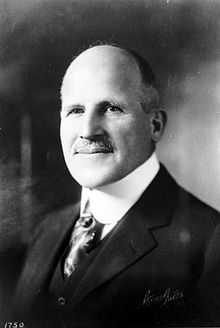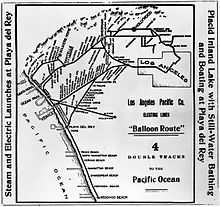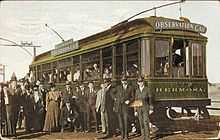Moses Sherman
| Moses Hazeltine Sherman | |
|---|---|
 Call called M. H. Sherman - General M. H. Sherman | |
| Born |
December 3, 1853 West Rupert, Vermont |
| Died | September 9, 1932 (aged 78) |
| Known for | Sherman Oaks, Los Angeles and Los Angeles Pacific Railroad |
Moses Hazeltine Sherman (December 3, 1853 – September 9, 1932) was an American land developer who built the Phoenix Street Railway in Phoenix, Arizona and streetcar systems that would become the core of the Los Angeles Railway and part of the Pacific Electric Railway in Los Angeles, California, and owned and developed property in areas such as west Los Angeles, the San Fernando Valley and Hollywood, California. He also served on the Los Angeles Water Board. He was also known as M. H. Sherman and General M. H. Sherman.
Biography
Early Life
Moses Sherman was born in West Rupert, Vermont, on December 3, 1853. He obtained a teaching certificate at the Oswego Normal School in Oswego, New York. He began as a teacher in Salem, New York and then Wisconsin, then moved to Arizona.
Early Career
In 1874, he moved to Prescott, Arizona, a small mining town where he continued teaching for two more years.[1] In Prescott, he acquired his capital brokering mines and ranches while a teacher. John C. Fremont, then Governor of Arizona, appointed Sherman State Superintendent of Public Instruction. He earned the title, "General" after his appointment as Adjutant-General of the Territory of Arizona, in which position he served two terms. He would use the title "General" for the rest of his life. In 1884, he helped found the Valley Bank of Phoenix, acting as President while simultaneously building the Phoenix Railway and some canal and water services.[1]
With associate M. E. Collins, he donated ten acres of land for the capitol in Phoenix when the town became capital of the territory in 1889. He moved to Los Angeles, California, in 1890 to speculate in land and use the new electric railway, or trolley system, to promote his real estate ventures. He made millions and sold control his Los Angeles Pacific lines to E.H. Harriman in 1906 for a reported additional six million dollars.[2]
Los Angeles Consolidated Electric Railway


He started the Los Angeles Consolidated Electric Railway,[3] and made his brother-in-law, Eli P. Clark, Vice President and General Manager.[4]
The Los Angeles Pacific Railroad
The Los Angeles Pacific Railroad was started in 1899 by Sherman and Clark, and at its peak had 180 miles of track in the western portions of Los Angeles County, from Pasadena, California to Santa Monica, running down the coast to Redondo Beach.[5] The rapid interurban transit of the Los Angeles Pacific Railroad, and the Pacific Electric system, the Big Red Cars, enticed many new residents to Los Angeles. It also helped Los Angeles get out the economic slump of the 1890s.[6] It encouraged new investments in manufacturing.[7] On June 16, 1903, Los Angeles Pacific Railroad merged with the Los Angeles-Santa Monica Railroad Company and the Los Angeles, Hermosa Beach and Redondo Railway Company. The new name after this merger was Los Angeles Pacific Railroad of California, but everyone continued to call it the Los Angeles Pacific Railroad. In March, 1906, an agreement was reached to sell control of the Los Angeles Pacific to E.H. Harriman’s Southern Pacific Railroad for a reported $6 million. [8]
Developing Los Angeles
Sherman/West Hollywood
At the junction of his streetcar lines west of Hollywood, he built carbarns and created a town called "Sherman". The town would eventually evolve to become the city of West Hollywood.[9]
Port Ballona/Playa del Rey
In the late-19th century, Moye C. Wicks and Louis Mesmer thought of turning the Playa del Rey estuary into a commercial port. They formed the Ballona Development Company in 1888 to develop the area, but three years later the company went bankrupt.
Sherman purchased 1,000 acres of land around the Ballona lagoon and Port Ballona in 1902 under the name the Beach Land Company. Sherman and Clark renamed the land "Del Rey". Port Ballona was then renamed Playa Del Rey. The port was serviced by the California Central Railway opened in September 1887, this line later became the Santa Fe Railway, that later became the Atchison, Topeka, and Santa Fe Railroad. The rail line ran from the port to Redondo junction. A street car tram line was built to the port by the Redondo and Hermosa Beach Railroad company, which had been incorporated on February 21, 1901. This company was part of the Los Angeles Pacific Railroad owned by Sherman and Clark. The tram line opened December 1902, departing from downtown at 4th & Broadway.[10][11]
San Fernando Valley

In 1904, in his role on the Board of Water Commissioners, he received advanced notice of purchases of water rights in the Owens Valley—Owens River for the proposed Los Angeles aqueduct, planned by William Mulholland and Fred Eaton. The additional water to Los Angeles, with the aqueduct's terminus in the San Fernando Valley, triggered a rush by land speculators to buy Valley real estate.[12] The formation of a land speculation syndicate, the Los Angeles Suburban Homes Company, included Moses Sherman and partners Hobart Johnstone Whitley, Isaac Newton Van Nuys, James Boon Lankershim, and Harry Chandler, manager of the "Los Angeles Times," as directors. The syndicate purchased the 47,500-acre (192 km2) parcel from the Los Angeles Farming and Milling Company, owned by Van Nuys and son-in-law Lankershim, in 1909. It comprised nearly the entire south half of the San Fernando Valley (south of present day Roscoe Blvd.). The price was $2,500,000, or just under $53 an acre.
As part of his speculation in the syndicate purchase, General Sherman (as he was called) retained property in what later became the neighborhood of Sherman Oaks, named for him.
The income Sherman received from real estate development made up for flagging railroad profits.
Pacific Electric Line and Sherman Way
In 1911 Sherman directed construction of the new San Fernando Line, a 20 miles (32 km) long extension of the Pacific Electric railway system, to serve the Los Angeles Suburban Homes Company developments. Starting at the terminus of an existing line over Cahuenga Pass from Hollywood to Lankershim (present day North Hollywood), the line went west through the townsite of Van Nuys in 1911, the mid-valley townsite of Marion (present day Reseda), to its terminus in the townsite of Owensmouth (present day Canoga Park) in 1912.
The streetcar line, with tracks along the "$500,000 boulevard" named Sherman Way, were the key to the development. By 1912, 45 minute streetcar service from Van Nuys to downtown and the "no speed limit" paved road (if you could get your "Model T" to do 30 mph) were key selling points.
The entire grand road's length was originally named "Sherman Way" in his recognition. The name remains on the westernmost original segment from Canoga Park and West Hills to Sherman Circle at Van Nuys Boulevard, and now also extends to Burbank. The easternmost original segment, with its electric railway right of way now a landscaped median/Orange Line route, survives as present day Chandler Boulevard. The north/south original segment, as present day Van Nuys Boulevard in Van Nuys, connects Chandler Boulevard to Sherman Circle. Hazeltine Avenue, which runs north/south from Sherman Oaks to Panorama City, was named after his daughter Hazeltine.
After low ridership and automobile advocacy, the Pacific Electric's San Fernando Line was closed in 1952. In the 2000s the MTA Orange Line restored a dedicated route for cross-valley public transportation. An exclusive busway, it uses the former San Fernando Line and Southern Pacific Railroad right of ways, from North Hollywood to Chatsworth. Sherman Way is currently served by local Metro bus routes 162/163.
Personal Life
He married Harriet Emily Pratt, daughter of Robert H. Pratt, a leading figure in the Central Pacific Railway of San Francisco. They married in 1885 and had two daughters, Hazeltine and Lucy; Sherman also adopted Harriet's son Robert Pierce from a previous marriage.[13]
Death
He died on September 9, 1932.
Notes
- ↑ 1.0 1.1 "Gen. Sherman's Career Closes". Los Angeles Times. September 10, 1932. p. A2.
- ↑ Friedricks, William (1992). Henry Huntington and the Creation of Southern California. Columbia: Ohio State University Press. p. 87.
- ↑ Electric Railway Historical Association of Southern California, ERHA.org, Los Angeles Consolidated Electric Railway, California Illustrated, 1892
- ↑ Out West, Volume 30, By Charles Fletcher Lummis
- ↑ erha.org, Los Angeles Pacific History
- ↑ St. James Park Web Site
- ↑ metro.net Los Angeles Transit History
- ↑ Friedricks, William (1992). Henry Huntington and the Creation of Southern California. Columbia: Ohio State University Press. p. 87.
- ↑ Masters, Nathan. (01 December 2011). "West Hollywood at 27: How the Town of Sherman Became WeHo". SOCAL FOCUS blog. Accessed 08 November 2012
- ↑ erha.org Los Angeles Pacific Corporate Histories
- ↑ delreync.org, Del Rey Neighborhood Council, Marina Del Rey History
- ↑ Gierach, Ryan (2003). Images of America: West Hollywood. San Francisco: Arcadia. p. 28. ISBN 0-7385-2850-1.
- ↑ Hendricks 8.
Other Reading
- Cosicia, Steven (2012). Pacific Electric and the Growth of the San Fernando Valley. Los Angeles, CA: Shade Tree Books.
- Crowe, Earle (1957). Men of El Tejon; Empire in the Tehachapis. Los Angeles, CA: Ward Ritchie Press.
- Easlon, Steven L. (1973). Los Angeles Railway Through the Years. Anaheim, CA: Easlon Publications.
- Fleming, Lawrence J. (1977). Ride a Mile and Smile a While: A History of the Phoenix Street Railway 1887-1948. Phoenix, AZ: Swaine Publications, Inc.
- Friedricks, Willam B. (1992). Henry E. Huntington and the Creation of Southern California. Columbus, OH: Ohio State University Press.
- Gierach, Ryan (2003). West Hollywood. Charleston, SC: Arcadia Publishing.
- Hendricks, William O. (1971). M.H. Sherman: A Pioneer Developer of the Pacific Southwest. Corona del Mar, CA: The Sherman Foundation. OCLC 3866940.
- Jorgenson, Lawrence C. (1982). The San Fernando Valley: Past and Present. Los Angeles, CA: Pacific Rim Research.
- Karhl, William L. (1983). Water and Power: The Conflict over the Los Angeles Water Supply in the Owens Valley. Berkeley, CA: University of California Press.
- Kupel, Douglas E. (2003). Fuel for Growth: Water and Arizona’s Urban Environment. Tucson, AZ: The University of Arizona Press.
- Mallory, Mary (2011). Hollywoodland. Charleston, SC: Arcadia Publishing.
- Mulholland, Catherine (2000). William Mulholland and the Rise of Los Angeles. Los Angeles, CA: University of California Press.
- Mulholland, Catherine (1987). The Owensmouth Baby: The Making of a San Fernando Valley Town. Northridge, CA: Santa Susanna Press.
- Myers, William, and Ira Swett (1976). Trolleys to the Surf: The Story of the Los Angeles Pacific Railway; Interurbans Special No. 63. Glendale, CA: Interurbans.
- Post, Robert C. (1989). Street Railways and the Growth of Los Angeles. San Marino, CA: Golden West Books.
- Seims, Charles (1982). Trolley Days in Pasadena. San Marino, CA: Golden West Books.
- Swett, Ira (1955). Los Angeles Pacific; Interurbans Special No. 18. Los Angeles, CA: Interurbans.
External links
 Media related to Sherman Way (Los Angeles) at Wikimedia Commons
Media related to Sherman Way (Los Angeles) at Wikimedia Commons Media related to Sherman Oaks, Los Angeles at Wikimedia Commons
Media related to Sherman Oaks, Los Angeles at Wikimedia Commons